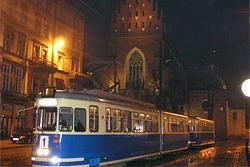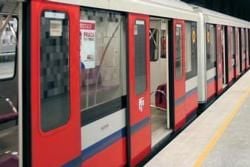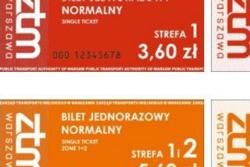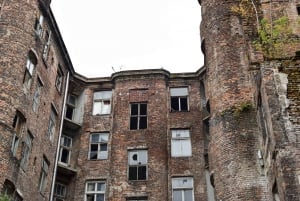Public Transport
Warsaw has a wealth of public transport available, including buses, trams and a metro system. City centre streets can be compact and crowded, while driving restrictions keep most traffic out of the Old Town area, so public transport is by far your best option for getting across town.
The public transport system is called ZTM (Zarzad Transportu Miejskiego).
Bus or Tram or Metro
Warsaw is extremely well-connected by bus, with additional lines available by tram. Bus and tram stops should be clearly identified, and have posted schedules listing the stops on the line and departure times. A good city map, easily available at any newsagent’s or book shop, should indicate bus and tram line numbers along the streets they service.
Warsaw is the only city in Poland to boast a metro system, a glory slightly lessened by the fact that there’s only one line. An additional line has been in the planning stage for many years, but is not likely to spring into existence anytime soon. The metro line runs north-south, connecting the city centre to major residential districts such as Mokotow, Ursynow and Zoliborz. It is quick, efficient and a good way to avoid street-level traffic jams.
Entrances to underground metro stations are clearly marked with the metro symbol and name of the station. Large display boards on each side of the platform indicate the terminus for trains traveling in that direction – Kabaty for south-bound trains, and Mlociny for north-bound trains. Metro stations tend to be clean, brightly lit and generally safe.
Detailed information about tickets and transport regulations can be found below.
Ticket Purchase
ZTM tickets are valid on all forms of public transport, including bus, tram, metro and urban rapid rail.
Tickets can be purchased at passenger service centres, post offices and most kiosks. There are also automatic ticket machines available throughout the city. Certain transport vehicles are equipped with ticket machines.
If you haven’t got a ticket before you get on the bus or tram, you can buy one from the driver (at a slightly higher price). Don’t expect them to have a wide choice of tickets, however, and definitely don’t expect them to have small change.
Ticket Types
Tickets include single fare, time-limit, short-term and long-term. They are available for Zone 1 or Zones 1 & 2, and marked as either standard fare (normalny) or reduced fare (ulgowy).
Single tickets are valid for one journey on a single line, until the last stop and for up to 120 minutes. Single tickets can be purchased for Zone 1, for Zones 1 & 2, and for Zone 1 off-peak (Monday-Friday 9:00-14:00). Note that if you change buses or trams during your journey, you will have to validate a new ticket. For journeys that require more than one line, it’s best to buy a time-limit ticket.
Time-limit tickets include 20-minute, 40-minute, 60-minute and 90-minute, and they are valid in both Zone 1 and Zone 2. They allow bearers an unlimited number of journeys, on all lines, within the time limit.
If you’re planning extensive use of public transport during your stay, you may want to purchase a short-term ticket instead. These tickets entitle you to unlimited use of the transport system for periods of 1, 3 or 7 days. 1-day tickets are valid for 24 hours after validation. 3- and 7-day tickets remain valid until 23:59 on the 3rd or 7th day after validation, regardless of the time of day at which the ticket was validated. These tickets may be purchased for Zone 1 or for Zones 1 & 2.
Long-term tickets function in the same way as short-term tickets, and are available for periods of 30 days and 90 days. These are only available on electronically-coded Warsaw City Cards (Warszawska Karta Miejska) or Electronic Student ID cards (Elektroniczna Legitymacja Studencka). These tickets should be validated on the first journey. Long-term tickets are also available for a single line, and are valid for journeys on any public transport, as long as the ticket holder is traveling within the limits of the indicated line.
The Senior Personal Pass is available to those 65 years of age and up. It entitles the bearer to an unlimited number of journeys within a year, and includes access to all ZTM lines. It is available only as an electronic WKM card.
Understanding your ticket
Bilet: ticket
Jednorazowy: single-journey
20-minutowy: 20-minute
Miedzyszczytowy: off-peak
Dobowy: 24-hour
3-dniowy: 3-day
Normalny: standard fare
Ulgowy: reduced fare (available only to Polish students and minors)
Przejazd: journey
Strefa: zone
Do kasowania: to be validated
Od PN do PT: from Monday to Friday
W Godz.: between the hours of
Transport Use and Regulations
If you’re traveling by bus or tram, make sure you validate your ticket as soon as you get on. Little yellow validating machines are easily visible on handrails nearest the doors. Simply insert your ticket into the slot to have it stamped. If you fail to do so, random checks by ticket controllers could land you with a heavy fine. If you’re using a single ticket, it will be good for one ride on a single bus or tram line. If you’re using a 1-hour, 1-day or other time-valid ticket, it will be good for unlimited rides within the time limit from the moment of validation (the time will be stamped on the ticket.)
If you’re traveling by metro, validate your ticket at the automatic entrance gate located at the platform. If you’re using your validated ticket for more than one entry (with a 1-hour, 1-day or similar ticket), simply insert the ticket into the slot as you would to validate it, and the gate will open. For passengers with limited mobility or heavy luggage, validating machines are also located beside lifts leading directly onto the platform.
Electronic tickets (long-term tickets only) are validated by placing the card in front of the marked reader on the validating machine.
A line map, marked with the line number and terminus points, is clearly visible on all public transport. The map displays each stop, and marks points where you can connect to other transport lines. Newer vehicles have electronic display boards giving the line number, route terminus, current stop and next stop ("nastepny przystanek" for ground travel or "nastepna stacja" for metro stations). Some vehicles also have automatic voice announcements.
Buses and trams stop at all standard stops. For request stops (na zadanie, marked "NZ" on line maps and bus schedules), press the "stop" or "na zadanie" button which is easily visible on handrails throughout the vehicle. Request stops are usually located in outer residential districts; note that if you don’t press the button before the stop, the bus will just go whizzing past, so make sure you know the name of the bus stop preceding your destination. If you’re getting on the bus from a request stop, you often have to flag the bus down if you want it to stop (it’s enough just to stand at the edge of the curb and stick your hand out as the bus approaches).
Luggage and animalsmay be transported without additional charge on all public transport lines. Luggage may not obstruct passageways or pose any sort of threat to passengers. Small animals should be in appropriate carriers. Dogs must be muzzled and held on a leash, and the dog’s owner should carry valid documents certifying the dog’s rabies vaccine. Animals and luggage should not be placed on seats.
It might be worth noting that in Poland, it is standard etiquette to give deference to the elderly, as well as to women. If you take a seat near the door or next to an aisle, be ready to give it up to an older passenger (while this is voluntary, you risk being given dirty looks by other passengers if you hog the seat.) Certain seats, usually at the front of a row, are marked as priority seating for the disabled, elderly or for those carrying small children. If you are a woman traveling alone, don’t be surprised (or offended) if a man offers you his seat on the bus – just smile and take advantage of the offer, since it’s usually crowded and rides can be bumpy on those uneven Warsaw roads.
























